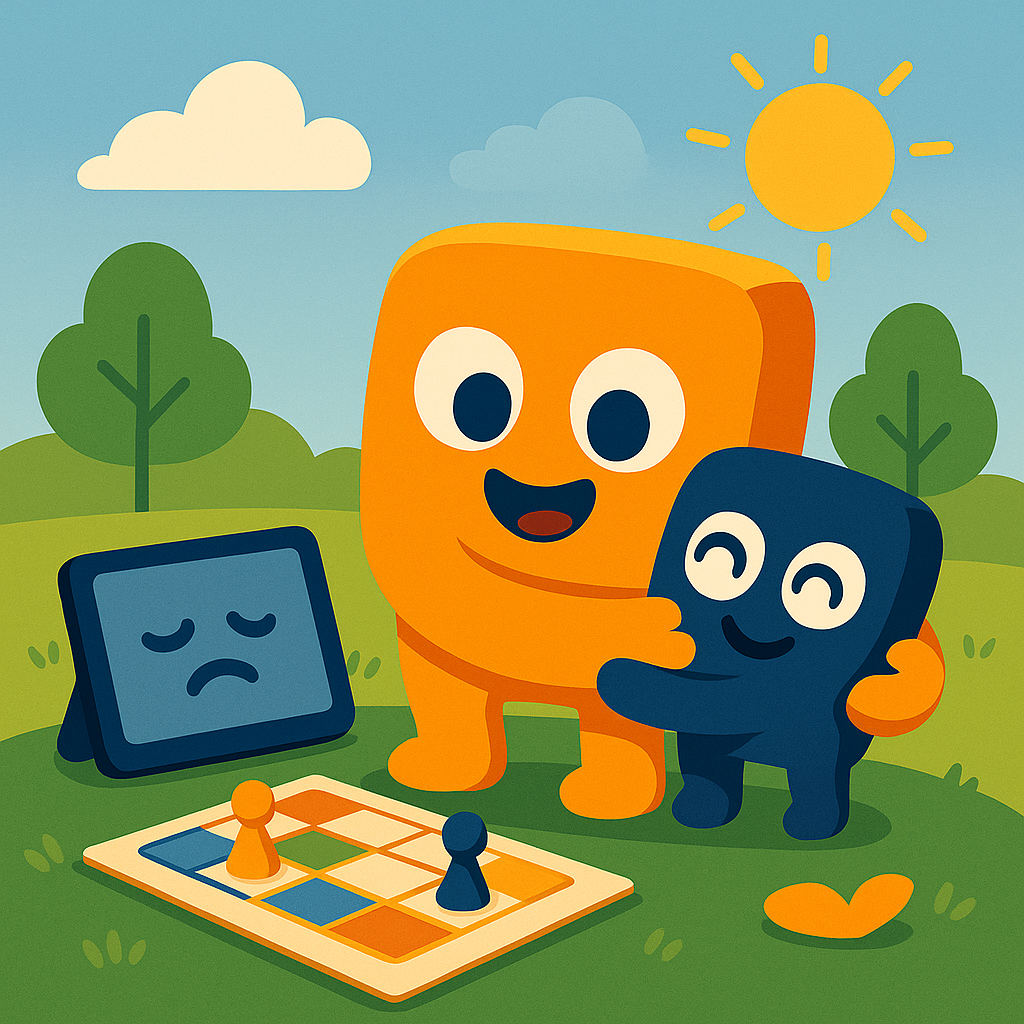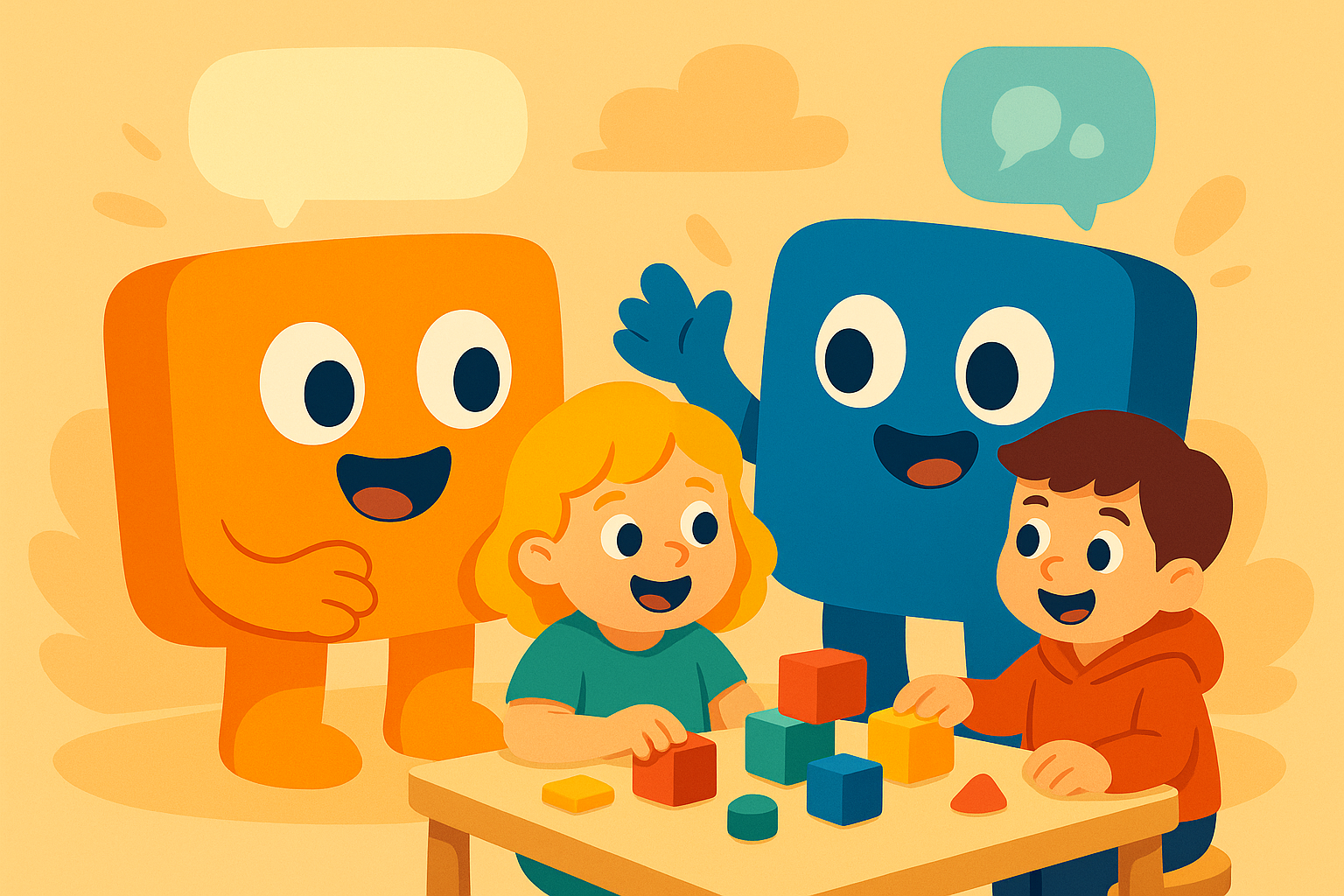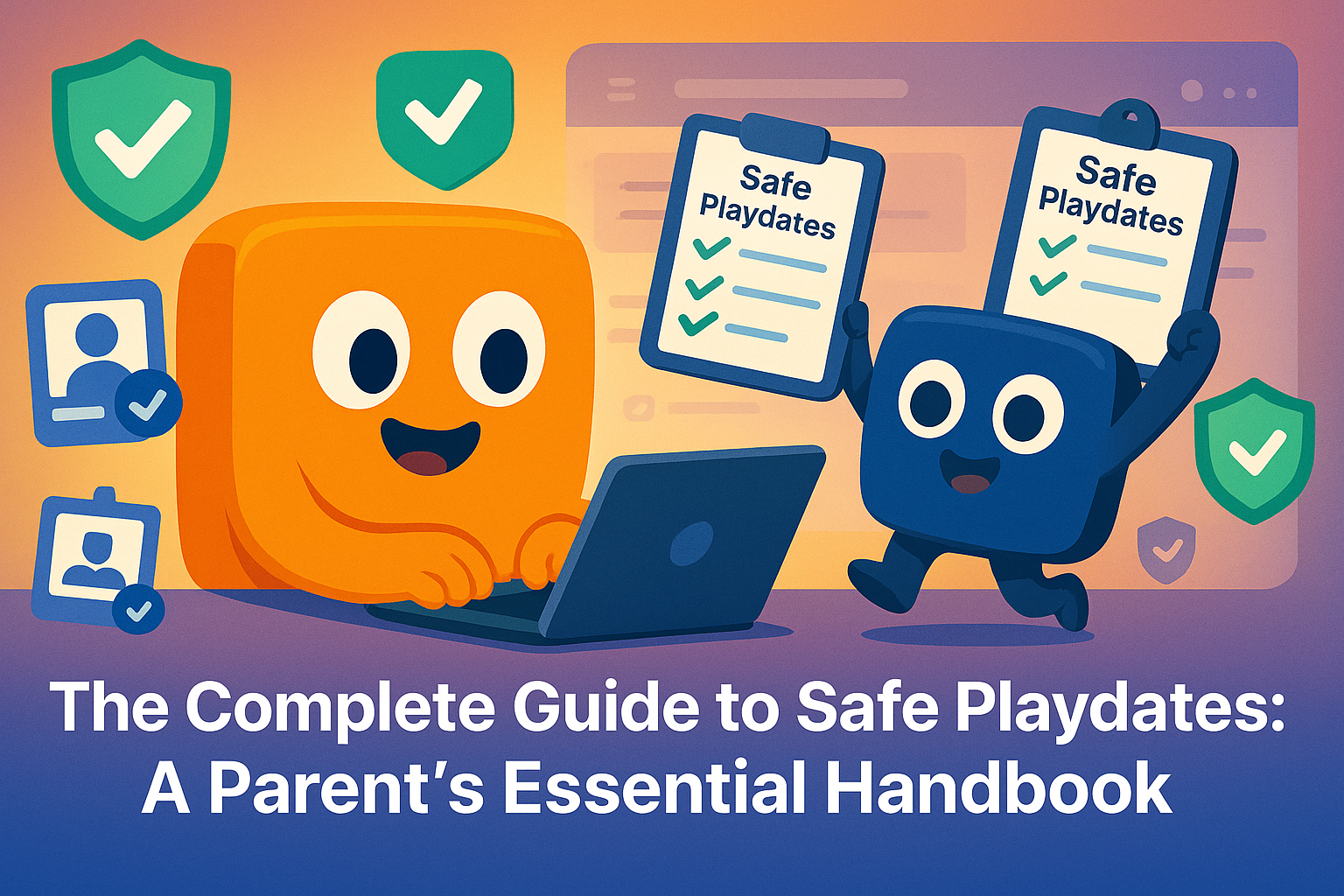Finding Balance: How to Reduce Screen Time and Increase Real-World Social Connections
In today's digital age, finding the right balance between screen time and real-world interactions has become one of the most challenging aspects of modern parenting. While technology offers incredible educational and entertainment value, excessive screen time can impact children's social development, physical health, and family relationships.
The goal isn't to eliminate screens entirely—that's neither realistic nor necessary in our connected world. Instead, it's about creating intentional boundaries that prioritize human connection while still embracing the benefits of technology.
Understanding the Impact of Excessive Screen Time
Physical Health Effects
Vision and Posture Issues:
- Digital eye strain from prolonged screen exposure
- Increased risk of myopia (nearsightedness) in children
- Poor posture leading to neck and back problems
- Reduced blinking leading to dry eyes
Sleep Disruption:
- Blue light exposure interfering with natural sleep cycles
- Difficulty falling asleep after evening screen use
- Reduced sleep quality and duration
- Impact on growth hormone production during sleep
Reduced Physical Activity:
- Sedentary behavior replacing active play
- Decreased cardiovascular fitness
- Weakened muscle development
- Increased risk of childhood obesity
Social and Emotional Development
Communication Skills:
- Reduced face-to-face conversation practice
- Difficulty reading non-verbal cues and body language
- Decreased empathy development
- Challenges with conflict resolution in person
Attention and Focus:
- Shortened attention spans for non-digital activities
- Difficulty with sustained concentration
- Increased need for constant stimulation
- Challenges with delayed gratification
Emotional Regulation:
- Using screens as primary coping mechanism for boredom or stress
- Difficulty managing emotions without digital distraction
- Increased irritability when screen time is limited
- Reduced tolerance for quiet or unstimulating moments
Family Relationship Impact
Quality Time Reduction:
- Parallel screen use replacing family interaction
- Decreased meaningful conversation during meals
- Reduced shared activities and experiences
- Weakened family bonding opportunities
Modeling Concerns:
- Children mimicking parents' screen habits
- Inconsistent family screen time rules
- Adults struggling with their own digital boundaries
- Mixed messages about technology priorities
Age-Appropriate Screen Time Guidelines
Toddlers (Ages 18 months - 2 years)
Recommended Limits:
- Avoid screens except for video chatting with family
- If introducing media, watch together and interact
- No independent screen time
- Focus on real-world exploration and play
Alternative Activities:
- Sensory play with textures and materials
- Simple puzzles and stacking toys
- Music and movement activities
- Reading board books together
Preschoolers (Ages 2-5)
Recommended Limits:
- Maximum 1 hour of high-quality programming per day
- Co-viewing with parents when possible
- Educational content with clear learning objectives
- No screens during meals or before bedtime
Quality Content Characteristics:
- Age-appropriate educational themes
- Slow-paced with clear narratives
- Interactive elements that encourage participation
- Content that connects to real-world experiences
Balance Strategies:
- For every hour of screen time, plan 2-3 hours of active play
- Use screens as a tool for learning, not just entertainment
- Create screen-free zones in bedrooms and dining areas
- Establish consistent daily routines that include both screen and non-screen activities
School-Age (Ages 6-12)
Recommended Approach:
- Focus on content quality over strict time limits
- Ensure screens don't interfere with sleep, physical activity, or family time
- Encourage educational and creative screen use
- Teach digital citizenship and online safety
Healthy Screen Habits:
- No screens during homework time (unless required for assignments)
- Family media plan with agreed-upon rules
- Regular screen-free family activities
- Gradual introduction of independent screen time with clear boundaries
Educational Screen Use:
- Research projects and online learning platforms
- Creative tools like digital art or music programs
- Video calls with distant family members
- Age-appropriate documentaries and educational videos
Teens (Ages 13+)
Balanced Approach:
- Collaborative rule-setting rather than strict limits
- Focus on healthy habits and self-regulation
- Address social media and online relationship concerns
- Maintain family connection despite increased independence
Key Considerations:
- Social media's impact on self-esteem and relationships
- Cyberbullying prevention and response
- Digital footprint awareness
- Balance between online and offline social connections
Creating Screen-Free Family Traditions
Daily Routines
Morning Rituals:
- Screen-free breakfast conversations
- Family planning for the day ahead
- Physical activity or outdoor time
- Mindfulness or gratitude practices
After-School Transitions:
- Dedicated time for sharing about the day
- Snack time without screens
- Homework completion before recreational screen time
- Physical activity or creative play
Evening Wind-Down:
- Family dinner without devices
- Reading time together
- Calm activities like puzzles or drawing
- Bedtime routines focused on connection
Weekly Family Activities
Outdoor Adventures:
- Nature walks and hiking
- Playground visits and active play
- Gardening and outdoor projects
- Sports and physical activities
Creative Projects:
- Art and craft activities
- Building and construction projects
- Cooking and baking together
- Music and performance activities
Social Connections:
- Playdates and family gatherings
- Community events and activities
- Volunteer opportunities
- Cultural experiences like museums or concerts
Special Occasions and Traditions
Screen-Free Celebrations:
- Birthday parties focused on activities and games
- Holiday traditions that emphasize family connection
- Vacation time with limited or no screens
- Regular family game nights or movie nights (as special occasions)
Seasonal Activities:
- Summer outdoor adventures and camps
- Fall nature exploration and harvest activities
- Winter indoor projects and cozy family time
- Spring gardening and outdoor renewal
Strategies for Reducing Screen Time
Gradual Transition Approach
Week 1-2: Assessment and Awareness
- Track current screen time usage for all family members
- Identify patterns and peak usage times
- Discuss family goals for screen time balance
- Begin introducing short screen-free periods
Week 3-4: Implementing Changes
- Establish screen-free meal times
- Create device-free bedrooms
- Introduce alternative activities during typical screen times
- Set up physical spaces for non-screen activities
Week 5-6: Building New Habits
- Extend screen-free periods gradually
- Plan regular family activities that don't involve screens
- Encourage children to suggest non-screen activities
- Celebrate successes and adjust rules as needed
Ongoing: Maintenance and Flexibility
- Regular family meetings about screen time rules
- Seasonal adjustments for weather and schedules
- Flexibility for special circumstances
- Continuous evaluation and improvement
Environmental Changes
Physical Space Modifications:
- Create inviting spaces for reading and quiet activities
- Set up art and craft stations that are easily accessible
- Organize outdoor equipment for spontaneous active play
- Designate specific areas for screen use
Device Management:
- Establish charging stations outside of bedrooms
- Use timers and parental controls as training tools
- Create physical barriers to impulsive screen use
- Make non-screen activities more accessible than screens
Alternative Activity Planning
Indoor Options:
- Board games and puzzles appropriate for different ages
- Art supplies and creative materials
- Building toys and construction sets
- Musical instruments and performance props
- Books and reading materials for all family members
Outdoor Alternatives:
- Sports equipment for various skill levels
- Gardening tools and supplies
- Nature exploration materials (magnifying glasses, collection containers)
- Sidewalk chalk and outdoor art supplies
- Bicycles and active transportation options
Building Real-World Social Connections
Facilitating Peer Relationships
Structured Social Opportunities:
- Regular playdates with consistent friend groups
- Participation in community activities and clubs
- Team sports and group activities
- Volunteer opportunities appropriate for children's ages
Teaching Social Skills:
- Role-playing common social scenarios
- Discussing friendship challenges and solutions
- Modeling positive social interactions
- Encouraging empathy and perspective-taking
Supporting Shy or Introverted Children:
- Start with one-on-one interactions before group activities
- Choose activities that match the child's interests and strengths
- Provide social scripts and conversation starters
- Celebrate small social successes
Community Engagement
Local Involvement:
- Participation in neighborhood events and activities
- Regular visits to community spaces like libraries and parks
- Involvement in local sports leagues or activity groups
- Attendance at cultural events and festivals
Service and Volunteering:
- Age-appropriate community service projects
- Helping neighbors with simple tasks
- Participating in charity drives and fundraisers
- Environmental stewardship activities
Cultural and Educational Experiences:
- Museum visits and educational outings
- Library programs and reading activities
- Cultural performances and artistic events
- Historical sites and educational tourism
Extended Family and Intergenerational Connections
Regular Family Gatherings:
- Weekly or monthly extended family meals
- Holiday celebrations that emphasize connection
- Family traditions that span generations
- Storytelling and family history sharing
Mentorship Opportunities:
- Connecting children with older family members or family friends
- Skill-sharing between generations
- Regular communication with distant relatives
- Learning traditional skills and crafts from elders
Addressing Common Challenges
Resistance and Pushback
Understanding the Resistance:
- Acknowledge that reducing screen time can be genuinely difficult
- Recognize that screens provide real benefits and entertainment
- Understand that change takes time and patience
- Address underlying needs that screens might be meeting
Strategies for Managing Resistance:
- Involve children in creating family screen time rules
- Provide compelling alternatives to screen activities
- Start with small changes rather than dramatic restrictions
- Focus on adding positive activities rather than just removing screens
Consistency and Follow-Through:
- Ensure all family members follow the same rules
- Address violations calmly and consistently
- Regularly review and adjust rules as needed
- Celebrate successes and progress
Practical Obstacles
Time and Energy Constraints:
- Start with simple, low-energy alternatives to screen time
- Prepare activities in advance during less busy times
- Accept that some days will be more screen-heavy than others
- Focus on progress rather than perfection
Weather and Seasonal Challenges:
- Develop indoor activity options for bad weather days
- Embrace seasonal activities and changes
- Plan ahead for challenging times of year
- Create cozy indoor alternatives to outdoor activities
Social Pressure and Peer Influence:
- Discuss family values and priorities with children
- Help children articulate their family's choices to peers
- Find like-minded families with similar values
- Balance family rules with social acceptance needs
Technology Integration
Educational Technology Use:
- Distinguish between educational and entertainment screen time
- Use technology as a tool for learning and creativity
- Encourage active rather than passive screen engagement
- Connect digital learning to real-world applications
Staying Connected:
- Use technology to maintain relationships with distant family and friends
- Teach appropriate digital communication skills
- Balance online and offline social connections
- Model healthy technology use for children
Long-Term Benefits of Balanced Screen Time
Individual Development
Enhanced Creativity:
- Increased imaginative play and creative problem-solving
- Development of artistic and musical abilities
- Improved ability to entertain oneself without external stimulation
- Greater appreciation for simple pleasures and activities
Improved Physical Health:
- Better sleep quality and duration
- Increased physical fitness and coordination
- Improved posture and reduced eye strain
- Greater awareness of physical needs and body signals
Stronger Social Skills:
- Enhanced face-to-face communication abilities
- Better conflict resolution and negotiation skills
- Increased empathy and emotional intelligence
- Stronger, more meaningful friendships
Family Relationships
Deeper Connections:
- More meaningful conversations and shared experiences
- Increased understanding of each family member's interests and personality
- Stronger family traditions and memories
- Better communication during challenging times
Improved Family Dynamics:
- Reduced conflicts over screen time and technology use
- More collaborative family decision-making
- Increased cooperation and teamwork
- Greater mutual respect and understanding
Academic and Professional Preparation
Enhanced Focus and Attention:
- Improved ability to concentrate on tasks for extended periods
- Better listening skills in educational and social settings
- Increased patience and persistence with challenging activities
- Greater appreciation for deep learning and mastery
Real-World Skills:
- Practical life skills developed through hands-on activities
- Problem-solving abilities honed through real-world challenges
- Leadership skills developed through group activities and social interactions
- Communication skills essential for future academic and professional success
Conclusion
Finding the right balance between screen time and real-world connections is an ongoing process that requires intentionality, flexibility, and patience. The goal isn't to eliminate technology from our lives, but to ensure that it enhances rather than replaces meaningful human connections and experiences.
Remember that every family's balance will look different based on their values, circumstances, and individual needs. What matters most is creating intentional boundaries that prioritize relationships, physical health, and personal development while still embracing the benefits that technology can offer.
Start small, be consistent, and focus on adding positive alternatives rather than just restricting screen time. With time and effort, you can create a family culture that values both digital literacy and real-world connections, preparing your children for success in our increasingly connected yet relationship-centered world.
The investment you make in reducing screen time and increasing real-world connections today will pay dividends in your children's social skills, creativity, physical health, and overall well-being for years to come.
Looking for families who share your values about balanced screen time? My Play Palz helps you connect with like-minded parents who prioritize real-world activities and meaningful connections for their children.




